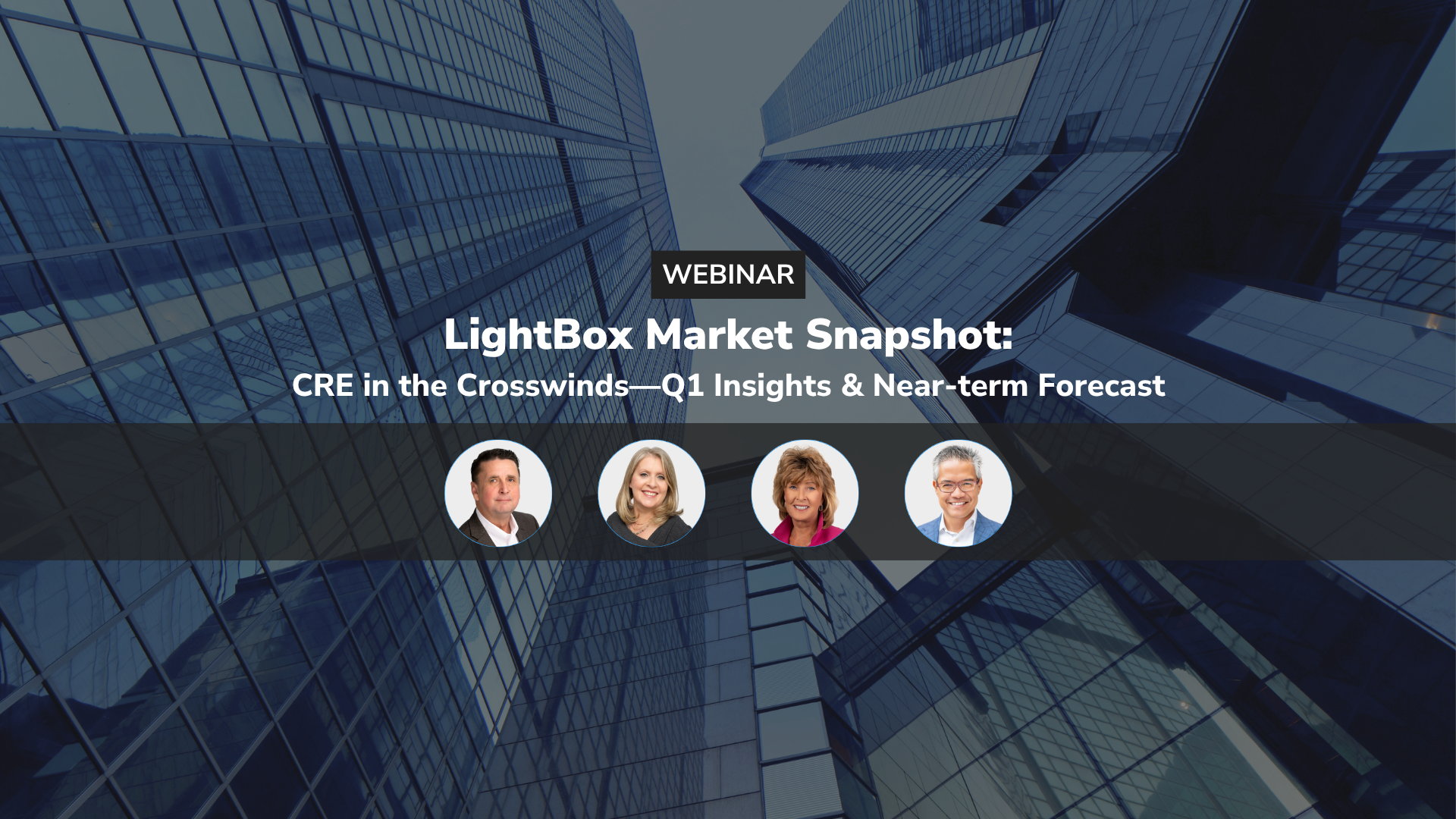One of LightBox’s most-attended webinars to date—“CRE in the Crosswinds: Q1 Insights & Near-Term Forecast”—cut through the noise and pushed back on the rising chatter that commercial real estate is on the brink of retreating.
Yes, there are headwinds. Yes, volatility is back. But this cycle is different—and we’ve got the data and industry voices to prove it. Here are the top five takeaways that matter right now for CRE professionals:
1. This Isn’t a Meltdown—It’s a Muddle-Through
While headlines continue to warn of a potential collapse, panelists pushed back on the idea that commercial real estate is heading for a 2009-style cliff. The panelists all agree: There has been no broad collapse in lending, no liquidity freeze, and no widespread panic. Instead, the market is showing selective stress—but surprising resilience.
“There’s a lot of money out there,” said Cindy Cooke, vice chair at Colliers. “I’ve not seen that in any down cycle before. It’s just being cautious—and it wants a home.”
CRE debt markets have held up better than expected. As Manus Clancy, head of Data Strategy at LightBox, noted that while volatility surged following tariff announcements in early April, key lending pipelines—like CMBS and bank originations—didn’t seize up. Even after the spike in Treasury yields and widening spreads, deals kept closing.
“Unlike other periods of heightened volatility, the markets continued to function,” said Clancy. “That was a positive sign.”
2. Momentum Is Building—Especially in Core Sectors
The LightBox Q1 data paints a clear picture: activity is returning across core market functions. Appraisal volume, environmental due diligence, and property listings all showed meaningful year-over-year growth.
- Property listings surged 48%
- Lender-driven appraisals rose 6%
- Phase I ESAs jumped 14%
These trends signal that the market is reawakening—not surging, but steadily reengaging. According to Dianne Crocker, research director at LightBox, Q1 saw the first real jolt of momentum in nearly a year, driven by increased lender engagement and seller confidence.
“If current trends hold, the Phase I ESA market is on track to achieve its second consecutive year of growth since 2021,” she noted.
And while not every listing translates to a closing, Crocker emphasized that listings are still the best leading indicator of market activity—an early sign of capital getting ready to move.
She also said that that investor interest is coalescing around multifamily, industrial, and retail assets, particularly in high-growth Sunbelt metros like Atlanta, Houston, and Phoenix.
3. Smart Capital Is Getting Back to Basics
Lending activity is showing signs of a cautious recovery. While origination volumes are still well below 2021 levels, the trendline is improving. Life companies, CMBS issuers, and debt funds are gradually getting back to business.
“2024 represented a turning point,” said Victor Calanog, global co-head of Research at Manulife. “By most measures, transaction volumes and originations were up significantly versus 2023.”
Still, this isn’t a market flush with risk-taking. As Calanog pointed out, even amid recovery, deal flow is being shaped by greater scrutiny—and more realistic assumptions. “Investment is tentative—essentially flat for now. I’m hoping that Q2 is not adversely affected by broader volatility,” he said.
The appetite to invest is there, but underwriting is tighter, expectations are lower, and execution matters more than ever. Lenders and equity partners alike are focused on how the asset performs today, not just its theoretical upside. And many are watching Q2 closely to see whether April’s volatility marks a pause—or a pivot.
4. Floating-Rate Fallout Is Still Playing Out
While many investors are regaining confidence, there’s a clear pocket of trouble still rippling through the market: floating-rate syndication deals from 2021–22. As interest rates rose sharply, debt service costs ballooned and some deals simply stopped penciling.
Syndicators who aggressively bought at compressed cap rates—expecting continued appreciation—are now facing refinancing challenges, rate cap costs, and in some cases, distress.
“If it was bought in ’21 or ’22, there’s a good chance the lenders are going to own that property,” said Cooke. “They just don’t pencil now.”
Panelists agreed that while this stress is real, it’s likely to remain contained. These are largely private equity-backed deals—not loans sitting on bank balance sheets—so the fallout may stay localized rather than systemic.
Still, the next wave of resets and maturities could test how much pain the market can absorb, particularly in oversupplied sectors like multifamily in the Sunbelt.
5. CRE’s Next Phase Will Be Defined by Execution
With the era of cap rate compression over, CRE success is shifting back to fundamentals. Asset management, tenant retention, and operational efficiency have once again become the difference-makers.
“You can’t count on cap rate compression anymore,” said Calanog. “Asset management has never mattered more.”
That shift is forcing a reversion to discipline. Investors are less focused on speculative upside and more focused on how well an asset performs today. Cooke added, “It’s no longer a capital play—it’s about how you’re managing the asset. Real estate 101 is back.”
It’s not just rhetoric. As volatility reshapes underwriting, lenders and equity partners alike are scrutinizing assumptions more closely. That favors experienced operators—and puts pressure on sponsors who were overly reliant on rising valuations.
As Q2 Unfolds: What to Watch
Capital is moving. But it is selective.
Key questions heading into the next quarter:
- Will lenders stay active—or tighten?
- Will investors keep circling—or start pulling the trigger?
Clancy noted: “This is not a market on its heels. At least not yet.”
Request the on-demand webinar replay to hear more actionable insights from Dianne Crocker, Victor Calanog, Manus Clancy, and Cindy Cooke on how today’s CRE cycle is unfolding—and what to watch in the quarters ahead.

